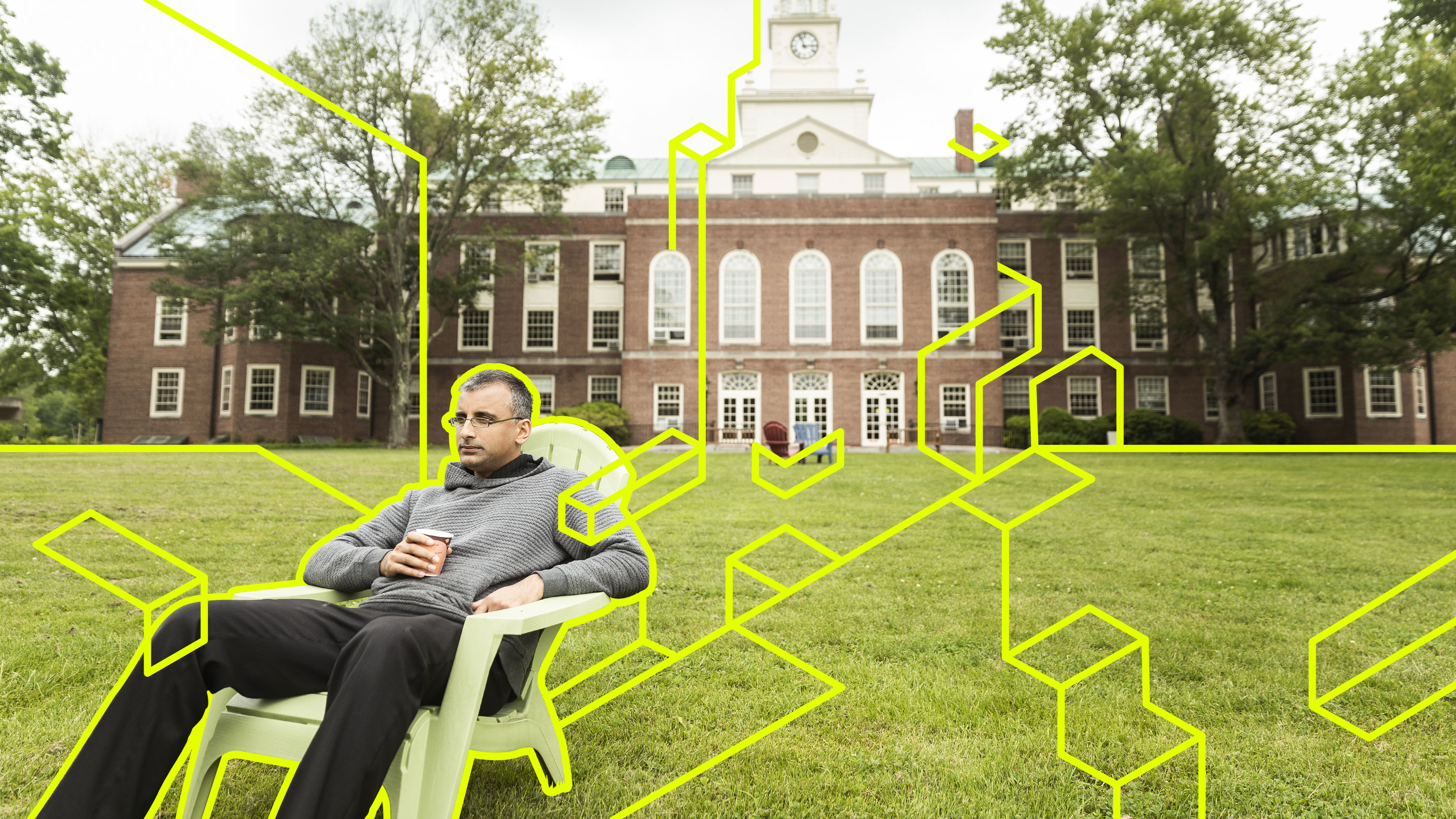
Akshay Venkatesh on the south lawn of the Institute for Advanced Study in Princeton, New Jersey.
Photo by Sasha Maslov for Quanta Magazine; Illustration by Olena Shmahalo/Quanta Magazine
Introduction
At the playground on the leafy campus of the Institute for Advanced Study in Princeton, New Jersey, one afternoon in May, the mathematician Akshay Venkatesh alternated between pushing his 4-year-old daughter on the swing and musing on the genius myth in mathematics. The genius stereotype does the discipline no favors, he told Quanta. “I think it doesn’t capture all the different kinds of ways people contribute to mathematics.”
Venkatesh’s other daughter, 7, wandered somewhere with her friends on the serene grounds of the institute’s visitor housing complex, which lends itself to the kind of free-range childhood that has become rare these days. Venkatesh had been visiting IAS for the past year, on leave from Stanford University; as of mid-August he will join the institute’s permanent faculty, whose previous members include Albert Einstein, Kurt Gödel and quite a few winners of the Fields Medal, the highest honor in mathematics.
Now the IAS can boast a brand-new Fields medalist in Venkatesh himself. The citation for his medal — awarded today at the International Congress of Mathematicians in Rio de Janeiro — highlights his “profound contributions to an exceptionally broad range of subjects in mathematics” and his “strikingly far-reaching conjectures.”
His ideas are “a vast expansion of the imagination,” said Michael Harris, a mathematician at Columbia University.
But back when Venkatesh was a graduate student at Princeton University around the turn of the millennium, the genius myth almost derailed his budding career. His early education — which carried him to college at age 13 and graduate school three years later — neatly fits the genius narrative. But on arriving at Princeton, Venkatesh was startled to discover that “there are a lot of people who are just as good at the things you thought defined being a mathematician, like being able to learn the material or solve problems fast.”
Mathematics research, with its winding paths and dead ends, was very different from the kind of math Venkatesh had excelled at in school, with its problem sets and clearly defined endpoints. Accustomed to meeting the highest of standards, he saw his dissertation as mediocre. Quietly, Venkatesh started eyeing the exit ramps, even taking a job at his uncle’s machine learning startup one summer to make sure he had a fallback option.
But then a plum job offer fell in his lap: one of the prestigious C.L.E. Moore instructorships at the Massachusetts Institute of Technology. Clearly, his adviser must have written a glowing letter of recommendation for him — but why? Venkatesh took this question to Jordan Ellenberg, a friend and fellow mathematician. Ellenberg’s reply has stayed with Venkatesh over the years: “Sometimes, people see things in you that you don’t see.”
Now 36, Venkatesh carries himself with the ease of someone who is thoroughly comfortable with his life choices. But it has taken him many years to see what other mathematicians have long seen in him. “It took me a long time to really feel satisfied with what I was doing,” he said.

Venkatesh said he works best in his office at the Institute for Advanced Study.
Sasha Maslov for Quanta Magazine
Most mathematicians struggle to describe the full range of Venkatesh’s diverse mathematical contributions, which build bridges from number theory to distant fields such as algebraic topology and dynamical systems. He is known for moving into an area of mathematics, transforming it, and then moving on.
“People always say there is no universal mathematician nowadays because it is too difficult,” said Emmanuel Kowalski, a mathematician at the Swiss Federal Institute of Technology Zurich. But, he said, Venkatesh’s mind “can think about anything.”
A Slow Unfolding
Venkatesh is more than ready for people to forget his math-prodigy story. “I’ll pay you not to mention any of this,” he joked. “I’m happy to leave that behind — it’s a little bit of being in a freak show.”
But growing up in Perth, Australia, where his parents moved from New Delhi when he was 2, Venkatesh didn’t feel like a freak. He described his boyhood as a “fairly normal suburban existence” filled with books (mostly fantasy and science fiction) and friendships. Venkatesh participated in physics and math Olympiads — the premier international competitions for high school students — and won medals in the two subjects at ages 11 and 12, respectively. But he values the friendships he made more than what he calls the “competitive sport” aspect of the Olympiads. “In retrospect I’m not so fond of the idea of Olympiads,” he said. “I think if that was what mathematicians really did, I wouldn’t enjoy being a mathematician.”
Mathematics is a comparatively straightforward subject in which to accelerate, since it doesn’t require vast amounts of life experience. After Venkatesh completed a math degree (with first-class honors) at the University of Western Australia in Perth at age 16, he rode his momentum to graduate school without really considering other alternatives. But he sees nothing foreordained in his choice. “I also would have been happy doing something else,” he said.
At Princeton, Venkatesh’s brilliance quickly became apparent to everyone except him. Once, when his housemate, Tony Wirth, showed Venkatesh his theoretical computer science textbook, Venkatesh instantly grasped the core concepts, Wirth recalled. “You’re dealing with a great mind when he can kind of plant himself in your area for a few minutes and really get to the bottom of it.”
And when Venkatesh first visited his adviser, Peter Sarnak, to ask for reading material, Sarnak decided to try him on a book about representation theory of semisimple groups — far from typical fare for first-year graduate students. Sarnak expected Venkatesh to return soon and demand something simpler. But a month later, Sarnak recalled, “he came back to my office explaining to me what he had read, and it was clear to me that not only was he understanding it, but he had a tremendous intuition about what it was all about.”
Venkatesh “always had remarkable insights,” said Sarnak, who is now at IAS. “It was clear that it was just a matter of time before he was going to put things together in unusual ways.”
Inwardly, though, Venkatesh was struggling. “I don’t feel like I had a happy time as a graduate student,” he said. He was disturbed by the fact that Sarnak had suggested one of the key ideas in his dissertation, even though that’s not uncommon in graduate studies. “I didn’t really feel like… I had added something very original,” Venkatesh said. “I don’t think I got the sense out of graduate school that I can do research.”
When he felt discouraged, Venkatesh would dive into some mathematics textbook, often on a topic far removed from his research. “I think that’s what has always kept me going, even when my own research hasn’t gone anywhere — I’ll read something and I’ll think, ‘Well, this is really wonderful,’” he said.
Venkatesh absorbed voluminous amounts of mathematics during his graduate years. It wasn’t intended as a strategic move, but it gave him the big-picture view that now allows him to discover connections other mathematicians have missed.
Over time, Venkatesh has come to understand that his struggles in graduate school stemmed from a lack of awareness of just what kind of mathematician he is. Unlike some mathematicians, who work intensively on a project and finish it up within months or a year, Venkatesh has found that his ideas often unfold over a much longer time frame. “You start to see that, well, a thought you had some years ago comes back and sort of has grown, because you’ve seen other things in the meantime,” he said. “It’s funny, I never would have described myself as a patient person. But that’s just how it is.”


Venkatesh at the mathematics and natural sciences library at the Institute for Advanced Study.
Sasha Maslov for Quanta Magazine
The Essence of Things
Emerging from graduate school in 2002 without having yet achieved this self-awareness, Venkatesh was eager to prove himself. A collaboration with Ellenberg soon gave him the opportunity. The pair took on the task of counting “number field extensions,” the simplest of which are built by adding to the rational numbers a handful of irrational numbers that satisfy some polynomial equation. These number systems “have a little bit of irrationality, but not too much,” said Ellenberg, who is now a professor at the University of Wisconsin, Madison.
There are infinitely many number field extensions, but there’s a natural way to measure how complex each one is, and the question then becomes to count how many there are below each complexity level. Venkatesh and Ellenberg figured out a new upper bound on these counts that greatly improved on the previous state of the art, which hadn’t budged for decades.
The project, Venkatesh said, was “psychologically very important” to him. “We got into this problem ourselves, and we really made progress on it.”
The pair originally tackled the problem using some new mathematical tools they’d heard about at a conference. But as they worked to improve the exposition of their proof, they eventually found that they had simplified away all the sophisticated new tools, Ellenberg said.
“It speaks to what I now recognize as being very characteristic of Akshay,” Ellenberg said. Their first, more technical version of the paper did prove their theorem. But for Venkatesh, Ellenberg said, it’s “not so much about whether you answered the question or whether you proved the theorem. It’s about: Did you understand what’s actually going on?”
Many mathematicians besides Ellenberg are struck by Venkatesh’s ability to distill ideas down to their essence. “When he’s finished, often his proof is the proof that would be in any textbook from here on,” Sarnak said.
“There have been lots of times in mathematics when someone has explained to me the right way to think about a certain piece of mathematics,” said Frank Calegari, of the University of Chicago. “But Akshay is one of the very few people who has done that with my own work.”
Soon after his work on number field extensions, Venkatesh carried out a new study that Sarnak calls his first “home run.” It concerned generalizations of the Riemann zeta function, which maps each number s to the infinite sum 1/1s + 1/2s + 1/3s + 1/4s + …. In 1859, Bernhard Riemann showed that knowing which values of s make this function spit out the number zero would tell mathematicians how many prime numbers there are that are smaller than any given number. But no one has succeeded in proving his hypothesis about where these “zeros” lie. The Riemann hypothesis, which has hundreds of consequences beyond explicating the distribution of prime numbers, is widely regarded as the most important unsolved problem in mathematics.
Since the mid-19th century, mathematicians have considered variants of the zeta function in which the ones in the numerators of the infinite sum are replaced by a more complicated sequence of numbers, generally a mix of positive and negative terms. Each of these “L-functions” has its own version of the Riemann hypothesis, which, if proved, would unlock other prime number mysteries, such as how prime numbers are distributed within various sequences of numbers.
These generalized Riemann hypotheses are also extremely hard to prove, so for decades, mathematicians have looked for ways to sidestep the hypotheses and prove some of their many consequences directly. One of the most important of these consequences is something called subconvexity, which says, roughly speaking, that the positive and negative numbers in the sequence of numerators of an L-function quickly start balancing each other out. Subconvexity estimates for L-functions, when they can be proved, yield statistical information about patterns in whole numbers — for example, one subconvexity estimate gives a description of the variety of ways any given large number can be written as the sum of three perfect squares.
Before Venkatesh turned his focus on L-functions, subconvexity estimates were commonly done on a case-by-case basis, often involving long papers full of technicalities, Kowalski said. But in 2004, Venkatesh sent the draft of a long paper to Philippe Michel, a mathematician now at the Swiss Federal Institute of Technology Lausanne who had studied subconvexity in depth. In the paper, Venkatesh used ideas from dynamical systems — the study of systems that change over time — to solve the subconvexity problem in much greater generality than had previously been accomplished. “The method was completely new,” Michel said. “It was a big shock to me.”
Venkatesh and Michel teamed up on a second paper that used this new approach to find subconvexity estimates for a huge family of L-functions. The pair of papers, along with several others Venkatesh wrote around that time, Sarnak said, “made him already one of the leading people in the world” in number theory and dynamics.
Collaborating with Venkatesh should perhaps feel intimidating, given the breadth of his knowledge and the depth of his insights — but somehow, it doesn’t. “He’s very strong technically, but talking to him doesn’t have a technical feel at all,” said Yiannis Sakellaridis, of Rutgers University, Newark. “You just talk about the essence of things.”
Searching Through the Fog
When I met with Venkatesh, he told me proudly that he had put up his daughter Tara’s hair in a “masterpiece” of a bun for her ballet dress rehearsal the day before. “I’ve written papers about the braid group,” he said. “Actual braids? Much harder.”
We strolled from his office to the institute’s preschool to pick up his younger daughter, Tuli, and then to their apartment in the visitor housing complex. Tara arrived soon after on the school bus, and Venkatesh settled in on the sofa, tickling Tuli while Tara eagerly described a science expo at her school.
Venkatesh was on solo parent duty, since his wife, Sarah Paden, who is finishing up her doctoral dissertation in musicology at Princeton, was away at a college reunion. It’s a role he slips into easily when she needs to travel, Paden said: He follows a comfortable groove that runs through the library, the coffee shop and home. Venkatesh is still an avid reader, although these days his book selection process usually involves simply snatching whatever looks interesting off the library shelf before his daughters drag him to the children’s section. At the moment, he’s rereading War and Peace. The writing is as wonderful as he remembers from his previous time through, but “it has these didactic passages that I find more annoying now than when I was younger,” he said.
Paden describes Venkatesh as a homebody. “Routine, consistency and home — these are comforts for him,” she said. They give him the freedom he needs, she said, to be adventurous in his mathematical life. “I feel like he takes leaps in his work that he doesn’t necessarily in life.”
The simplicity of life at IAS, with its on-site housing and child care, makes it a congenial environment for Venkatesh. There’s coffee — one of his small joys in life — down the hall from his office and in the cafeteria, though there too he has established a routine to make sure he doesn’t overindulge: one coffee at home over breakfast, one midmorning at the institute, and one after lunch. His office has the rare luxury of a second blackboard, which he has tiled with small boxes, iPhone style, containing reminders ranging from “Brazil visa” and “Chapter 13” to mathematical formulas.
And life at the institute provides the two elements most essential for Venkatesh’s research: large blocks of unbroken time, and an office big enough for him to pace around in while he thinks. Back at Stanford, a patio outside the math department filled a similar function.
Venkatesh feels a mix of shock over winning the Fields Medal and nervous anticipation of the spotlight it will cast over his career. In graduate school, he studied the work of many earlier Fields medalists, he said. “It’s very difficult to grasp that I’m one of them.”
He has mixed feelings about prizes, since they tend to reinforce the myth of the lone genius. And, he says, “I have gotten probably more than my fair share of them.”
He was especially surprised to win the Fields Medal because much of his recent work has been highly conjectural, and the medal often goes instead to people who have solved some big well-known problem. “My work is not of that nature, nor did I attempt for it to be of that nature,” he said.
Yet it’s this recent, highly speculative work that Venkatesh feels happiest about. It concerns the Langlands program, a vast web of connections between number theory, geometry and analysis.
At the heart of the program is a correspondence — much of it still shrouded in fog — between shapes that arise in two different contexts. On one side of the correspondence are “motives,” shapes related to the solution sets of polynomial equations (similar to the way the circle represents the solutions to the equation x2 + y2 = 1). On the other side are shapes constructed by gluing the edges of a “tile” together; for instance, a torus, or doughnut shape, can be built by gluing the opposite edges of a square tile (though the Langlands program focuses on tiles akin to the curved angels, devils and fish that fill M.C. Escher’s Circle Limit woodcuts). One of the best-understood of these correspondences between motives and tiles formed the core of Andrew Wiles’ 1994 proof of Fermat’s Last Theorem.
Sometimes, the glued-up tiles have a special kind of twistedness, called torsion, that the classical methods of the Langlands program cannot detect. When Venkatesh first heard about interesting examples of this torsion, “I was extremely struck,” he said. “I became convinced there was something rich there to be found.”
In 2009, Venkatesh and Nicolas Bergeron of Pierre and Marie Curie University in Paris showed that torsion is abundant in the glued tiles that appear in Langlands correspondences. And in the past few years, Venkatesh and several collaborators have explored a range of other features of these shapes that Venkatesh says are “mathematically deeper, but … less visible.”
“Langlands is already giving kind of a dictionary between these objects,” Calegari said. “Now Akshay is saying, ‘Hang on, there’s something even more precise.’”
So far, Venkatesh has only proved a small slice of his overarching conjectures. “But at least now the picture of what should be true is clear,” he said.
This kind of investigation, in which Venkatesh is feeling his way through a nebulous landscape, is what he has come to recognize as his sweet spot. Early in his career, when he felt pressure to impress people, he tended to work on established problems even though doing so left him vaguely unsatisfied. But lately, he said, he has learned to embrace the sensation of being on the track of “something interesting that hasn’t been exploited, or something anomalous that doesn’t quite make sense.”
During the past year at the institute, Venkatesh and Sakellaridis have been investigating two separate questions, one concerning L-functions and the other an extension of Venkatesh’s recent work on the Langlands program. Mysteriously, these two separate strands seem to be converging on the same underlying question. “That’s a very good sign,” Venkatesh said.
“I don’t know exactly where it will lead,” he said. But “there’s something there now, for sure.”




